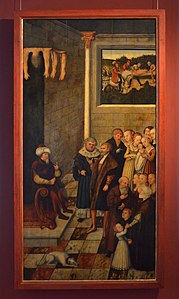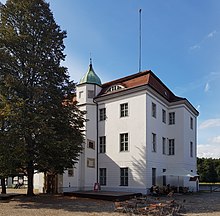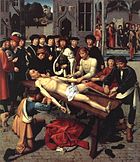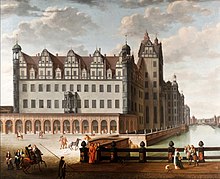Exemplum panels of Elector Joachim II.
The Exemplum panels by Elector Joachim II are a four-part series of paintings, each measuring 209.5 × approx. 107 centimeters, made of limewood from the workshop of Lucas Cranach the Elder , which is dated to 1540/1545. They show motifs from Christian mythology ( Old Testament ) David and Bathsheba and David fights with Goliath , as well as from Greek mythology the ancient motifs The Judgment of Paris and The Judgment of Cambyses as Tugendexempla, which represent the lordly virtues of moderation , wisdom , justice and Represent courage . The panels were part of the furnishings of the Berlin Palace , only the Kambyses panel was part of the furnishings of the Berlin Chamber Court . They are managed by the Prussian Palaces and Gardens Foundation under the inventory numbers SPSG, GK I 1185–1188. The boards have been on display in the Grunewald hunting lodge since 2011 .
description
The four panels David and Bathsheba , The Judgment of Paris , David Fighting Goliath and The Judgment of Cambyses were created as a series of images. Their unusual portrait format indicates that they were created for a specific spatial situation. A restoration report is available for the 1980s . Accordingly, three of the paintings showed vertical cracks in the image carrier and color contrasting, while the Cambyses panel showed only isolated color contrasting and its overall condition was rated as good.
David and Bathsheba

|
| David and Bathsheba |
|---|
| Cranach workshop , 1540/45 |
| Oil on linden wood |
| 209.5 x 107 cm |
| Grunewald hunting lodge |
The panel with the representation of David and Bathsheba refers to an episode from the 2nd book of Samuel . King David watches the wife of his general Uriah , Bathsheba , bathing and falls in love with her. First he takes her as his lover. When Bathsheba becomes pregnant, he sends her husband to death. Then David takes Bathsheba as his wife. The vertical panel measuring 209.5 × 107 centimeters shows Bathsheba in the right foreground with five companions in contemporary court dress on the bank of a river. A younger girl in a white dress stands with both feet in the water and dries the right foot of the seated Bathsheba on her hem. The group of women is caught behind by bushes, from the left in front a tree trunk protrudes over the river. In the middle distance rises a tower on the left, on which King David and two companions are in the upper left corner of the picture. The king leans over the parapet and plays a harp to seduce Bathsheba. In the upper right part of the picture a mountainous landscape disappears in the background. Bathsheba 's chaste clothing and David's active efforts lead to the fact that the focus is less on the warning against female lust than the general warning against the sin of adultery and thus the call for moderation as the message of the image.
Lucas Cranach the Elder took up the motif of David and Bathsheba several times. Among other things, there is a board in landscape format in Dresden , which is compositionally very different from the portrait format board in Berlin. The collection of the Museum of Fine Arts in Leipzig includes a drawing that probably served as a preliminary drawing for the Berlin panel. It shows the two groups of figures, the architecture and the landscape, but not yet in the stretched version of the painting. Instead, the preliminary drawing is characterized by a more compact composition. In Luther's great catechism of 1529, Lucas Cranach the Elder used a similar representation to illustrate the 6th commandment (you should not commit adultery) .
- Lucas Cranach the Elder, David and Bathsheba
Oil on beech wood, 38.8 × 25.7 cm, 1526, Gemäldegalerie Berlin
Pen and brown ink, gray wash, 20.6 × 16.6 cm, around 1540, Museum der bildenden Künste Leipzig
The judgment of Paris

|
| The judgment of Paris |
|---|
| Cranach workshop , 1540/45 |
| Oil on linden wood |
| 209.5 x 107.2 cm |
| Grunewald hunting lodge |
The 209.5 × 107.2 centimeter panel shows the judgment of Paris , one of the most famous episodes of Greek mythology . The Trojan prince Paris should choose the most beautiful of the goddesses Hera , Athena and Aphrodite . All three promise him something in return for his choice: Hera Macht, Athene Weisheit and Aphrodite the love of the most beautiful woman. Paris opts for the latter; However, Helena , the most beautiful mortal, is the wife of the Spartan King Menelaus , which is why the Trojan War breaks out. In the foreground on the left, Paris in full armor sits dreaming on stones. The decision seems to have already been made, since one of the three goddesses portrayed naked is standing in front of him and has placed her left hand on his breastplate, while the other two are standing on the right edge of the picture. On a step in the middle distance stands the bearded figure of the messenger of the gods Hermes , feathered all over his body , who has opened his mouth to a shout and hits the prince's chest with his staff to warn him of the wrong decision. In the background the landscape opens up, while in the sky above the group of figures Amor hovers with a drawn bow.
Around 1500 the judgment of Paris was a popular topic for the German humanists , who saw the choice of the right path in life as a theme in this story. The addressee should not follow Paris' bad example, but instead opt for wisdom. The depiction of the Berlin panel differs from other paintings of this subject both by Lucas Cranach the Elder and by other artists in that the three goddesses are not individualized and therefore indistinguishable.
- Lucas Cranach the Elder, The Judgment of Paris
Oil on beech wood, 84.7 × 57 cm, 1528, Kunstmuseum Basel .
Oil on beech wood, 35 × 23.7 cm, 1530, Staatliche Kunsthalle Karlsruhe .
Oil on panel, 50.5 × 38 cm, 1527, Statens Museum for Kunst .
Oil on limewood, 43 × 32.2 cm, 1512/14, Kimbell Art Museum .
David fights with Goliath

|
| David fights with Goliath |
|---|
| Cranach workshop , 1540/45 |
| Oil on linden wood |
| 209.5 x 106.6 cm |
| Grunewald hunting lodge |
In the first book of Samuel it is described how the shepherd boy David defeated the general of the Philistines , Goliath , with a slingshot . This ensured Israel military success. The whole length of the foreground of the 209.5 × 106.6 centimeter panel is taken by Goliath lying on the ground in his armor. David stands above him with his right foot on his pubic area. With both hands he wields the sword in order to finally kill the opposing general. The slingshot, which is actually central to the story, lies on the floor. The middle distance of the picture shows a deserted landscape; on the left a little wood, on the right edge of the picture a barren area. In the background is the army of the Philistines, over which a rock arch arches. The focus on the two opponents with David in the energetic pose underscores the virtue of bravery and courage.
David's fight against Goliath was an unusual choice for the sequence of images. The motif was quite rare in the early modern period, and is not found a second time in the oeuvre of Cranach the Elder.
The judgment of Cambyses

|
| The judgment of Cambyses |
|---|
| Cranach workshop , 1540/45 |
| Oil on linden wood |
| 209.4 x 107.1 cm |
| Grunewald hunting lodge |
The Greek historian Herodotus described in his histories the story of the Persian King Cambyses II , who convicted the corrupt judge Sisamnes and had him skinned alive as a punishment. The skin was then stretched on the judgment seat on which Cambyses commanded the son of Sisamnes, Otanes . The 209.4 × 107.1 centimeter panel unites two moments in history: Otanes sits on the left edge of the picture on the judge's throne, whose canopy is made of his father's skin. He is holding a staff in his right hand, the thumb and forefinger of the left are outstretched. With the turban, Otanes is the only figure in the painting marked as historical. In front of him is a group of many figures in contemporary clothing. Some faces seem to have been designed individually, but it is more of a typical court scene. The rear wall reveals the scene of the molting of Sisamnes.
The subject of the judgment of Cambyses had been popular since the late 15th century and was particularly found in German and Dutch town halls, where it served as a warning against corruption. This circumstance also suggests that the Berlin Tafel is a typical court scene, which in an abstract way shows the just judge as a model for ruling justice. The panel from the Cranach workshop is typical: the son Otanes was central to the visual representation of the story, while the punishment of his father was relegated to the background in most of the German and Dutch depictions. Cranach's invention of images of the Berliner Tafel was probably received in the Netherlands. A representation of this subject, which was in the chamber of a councilor in Middelburg and has been handed down through a graphic, shows a similarly high hanging of the skin of Sisamnes over the throne as well as a similar representation of the execution of the judgment, seen through a window.
Gerard David , The Capture of Judge Sisamnes , oil on wood, 182 cm × 159 cm, 1498, Groeningemuseum .
Dutch, The Judgment of Cambyses , after a lost painting, drawing, 16th century, Rijksarchief Zeeland .
background
Genesis and Divorce
Lucas Cranach the Elder traveled to Berlin in 1541 at the request of Elector Joachim II . This could have been related to the furnishing of the hall of the recently completed Stechbahn wing of the Berlin Palace. Until the handover of the workshop to his son, Lucas Cranach the Younger , in 1550, Lucas Cranach the Elder took on the conception of important commissions himself. The complexity of the content and form of the four panels suggests that they, too, go back to designs by Cranach the Elder. These were then quickly carried out by the workshop, probably under the guidance of Lucas Cranach the Younger. Hence the inconsistencies in proportions and other formal details. Max J. Friedländer , Jakob Rosenberg and Werner Schade assume that the four panels were entirely by Lucas Cranach the Younger. Another argument in favor of the attribution to Lucas Cranach the Younger was the lack of clear signatures on the Exemplum tablets, which were characteristic of Cranach the Elder.
The Depiction of Virtue Exempla
The four panels show motifs that were popular as examples of virtue during the Renaissance : They were used both in princely mirrors , which were used to educate princes , and to furnish representative rooms in castles and town halls. Both the virtues and the vices of well-known historical and mythological personalities should serve as a yardstick and model for political action in the present. Two functions can be distinguished: On the one hand, they could have a direct moral-didactic function that was intended to guide councilors and princes to act correctly, and on the other hand, they could serve to legitimize political power and claims of a virtuous prince. In the oeuvre of Lucas Cranach the Elder, there have been numerous moralizing motifs since joining the Wittenberger Hof, which he repeatedly depicted and developed. As a rule, these were not individual motifs, but rather cycles that can be assigned based on their dimensions and provenance . For example, around 1537 he created the series of women power pictures , in which the negative consequences of the female seduction of the male regent were to be shown, probably for Hartenfels Castle in Torgau , the residence of the Saxon elector. This series could have served as a model for the Berlin paintings.
Provenance
The four Exemplum panels of Elector Joachim II were probably created for furnishing the hall in the Stechbahn wing of the Berlin Palace. At an unknown time, they were brought together with the other Cranach factories in the so-called Cranach room , where they were embedded in the wall paneling. The tablets were later placed in the palace chapel. The images David and Bathsheba , The Judgment of Paris and David Fights with Goliath can be traced back to the year 1793 in the castle. In the 17th century, the Great Elector Friedrich Wilhelm von Brandenburg (1620–1688) transferred the Kambyses panel to the Berlin Supreme Court , from where it returned to the palace between 1811 and 1816. The elector had the picture hung in the courthouse because he was dissatisfied with a judgment. The picture was intended to show the judges how inadequate officials were dealt with in earlier times.

A few days after the November Revolution in 1918, the property of the House of Hohenzollern was confiscated, and the art collection came under the administration of the Prussian Ministry of Finance. The dispute over the so-called expropriation of princes was settled on October 26, 1926 with the law on the property dispute between the Prussian state and the members of the formerly ruling Prussian royal family ; In 1927 the administration of the State Palaces and Gardens was founded, to whose collection the Exemplum panels of Elector Joachim II belonged from then on. From 1921 they were part of the palace museum set up in the Berlin Palace , which in particular housed the collection of the Kunstgewerbemuseum . After 1929 and before 1935, as the room photographs show, the panels were hung one floor lower in the Erasmus Chapel, where they formed the prelude to the historic living rooms with other works by the Cranachs.

In 1938 the four panels together with a Madonna (Caritas) by Hans Baldung Grien from the Grunewald hunting lodge were transferred to the German Museum in the Pergamon Museum as permanent loans . Before that, they were already on view in the spring of 1937 in the Cranach exhibition of the State Museums. The panels remained in the collection of the Gemäldegalerie Berlin ; In 1987 they were included in the inventory catalog. Since 2011, the Exemplum boards of Elector Joachim II with the other Cranach works of the Prussian Palaces and Gardens Foundation Berlin-Brandenburg, which they have under the inventory numbers SPSG, GK I 1185–1188, in the Grunewald hunting lodge as part of the largest Cranach Collection of Berlin exhibited.
literature
- Max J. Friedländer : Old German and Old Dutch Schools . In: Paul Seidel, Wilhelm Bode, Max J. Friedländer (eds.): Paintings by old masters in the possession of His Majesty the German Emperor and King of Prussia . Berlin / Leipzig / Stuttgart / Vienna 1906, p. 45-77 , doi : 10.11588 / diglit.23711 ( digi.ub.uni-heidelberg.de ).
- Max J. Friedländer, Jakob Rosenberg: The paintings by Lucas Cranach . Birkhäuser Verlag, Basel / Berlin 1979, ISBN 3-7643-0982-2 , urn : nbn: de: bsz: 16-diglit-110590 (first edition: 1932, expanded new edition).
- Dieter Koepplin, Tilman Falk (eds.): Lukas Cranach. Paintings, drawings, prints. Basel / Stuttgart 1974/1976 (volumes 1 and 2), ISBN 3-7643-0708-0 .
- Kunze: On the transfer of the Madonna (Caritas) by Hans Baldung Grien from the Grunewald hunting lodge to the German Museum. In: Berlin museums. 59th volume, issue 1, 1938, JSTOR 4237960 , pp. 1–4.
- Rainer Michaelis: German paintings. 14.-18. Century (= Catalog Staatliche Museen zu Berlin Gemäldegalerie. Volume III). Self-published, Berlin 1989.
- Gerd Bartoschek, Ruben Rebmann, Elke Anna Werner: Cranach and the art of the Renaissance under the Hohenzollern: Church, courtyard and urban culture - An exhibition by the Prussian Palaces and Gardens Foundation in Berlin-Brandenburg in cooperation with the Evangelical Church Congregation St. Petri - St. Marien . Ed .: Foundation Prussian Palaces and Gardens Berlin-Brandenburg, State Museums in Berlin. Deutscher Kunstverlag, Berlin 2009, ISBN 978-3-422-06910-7 .
Web links
- David and Goliath on museum-digital.de
- Bathsheba on museum-digital.de
- Verdict of Paris on museum-digital.de
- David fights Gloiath on lucascranach.org
- David and Bathsheba on lucascranach.org
- Judgment of Paris on lucascranach.org
- The verdict of Cambyses on lucascranach.org
Individual evidence
- ↑ a b Elke A. Werner: The Exemplum panels of Elector Joachim II. In: Foundation Prussian Palaces and Gardens Berlin-Brandenburg & Evangelical Church Community St. Petri-St. Martin (Hrsg.): Cranach and the art of the Renaissance under the Hohenzollern. Church, courtyard and city culture. Deutscher Kunstverlag, Berlin / Munich 2009, pp. 200–201.
- ^ Rainer Michaelis: German paintings. 14.-18. Century. 1989, pp. 25-28.
- ↑ a b c d Elke A. Werner: The Exemplum panels of Elector Joachim II. In: Foundation Prussian Palaces and Gardens Berlin-Brandenburg & Evangelical Church Community St. Petri-St. Martin (Hrsg.): Cranach and the art of the Renaissance under the Hohenzollern. Church, courtyard and city culture. Deutscher Kunstverlag, Berlin / Munich 2009, p. 201.
- ↑ Elke A. Werner: The Exemplum panels of Elector Joachim II. In: Foundation Prussian Palaces and Gardens Berlin-Brandenburg & Evangelical Church Community St. Petri-St. Martin (Hrsg.): Cranach and the art of the Renaissance under the Hohenzollern. Church, courtyard and city culture. Deutscher Kunstverlag, Berlin / Munich 2009, pp. 201–202.
- ^ Elke A. Werner: David and Bathsheba. Around 1540. In: Foundation Prussian Palaces and Gardens Berlin-Brandenburg & Evangelical Church Community St. Petri-St. Martin (Hrsg.): Cranach and the art of the Renaissance under the Hohenzollern. Church, courtyard and city culture. Deutscher Kunstverlag, Berlin / Munich 2009, p. 203.
- ↑ a b c Elke A. Werner: The Exemplum panels of Elector Joachim II. In: Foundation Prussian Palaces and Gardens Berlin-Brandenburg & Evangelical Church Community St. Petri-St. Martin (Hrsg.): Cranach and the art of the Renaissance under the Hohenzollern. Church, courtyard and city culture. Deutscher Kunstverlag, Berlin / Munich 2009, p. 202.
- ↑ Elke A. Werner: The Exemplum panels of Elector Joachim II. In: Foundation Prussian Palaces and Gardens Berlin-Brandenburg & Evangelical Church Community St. Petri-St. Martin (Hrsg.): Cranach and the art of the Renaissance under the Hohenzollern. Church, courtyard and city culture. Deutscher Kunstverlag, Berlin / Munich 2009, pp. 202–203.
- ↑ a b Elke A. Werner: The Exemplum panels of Elector Joachim II. In: Foundation Prussian Palaces and Gardens Berlin-Brandenburg & Evangelical Church Community St. Petri-St. Martin (Hrsg.): Cranach and the art of the Renaissance under the Hohenzollern. Church, courtyard and city culture. Deutscher Kunstverlag, Berlin / Munich 2009, p. 203.
- ^ Hugo van der Velden, Cambyses for Example: The Origins and Function of an exemplum iustitiae in Netherlandish Art of the Fifteenth, Sixteenth and Seventeenth Centuries. In: Simiolus: Netherlands Quarterly for the History of Art. Volume 23, No. 1, 1995, pp. 5-62, here pp. 29-30.
- ↑ Max J. Friedländer & Jakob Rosenberg, The paintings of Lucas Cranach. 1979, ISBN 3-7643-0982-2 , pp. 141 and 153.
- ^ Gunnar Heydenreich, Ingo Sandner, Helen Smith-Contini: Changes in signing in Cranach's workshop and the way his son Lucas worked. In: Elke A. Werner, Anna Eusterschulte, Gunnar Heydenreich (eds.): Lucas Cranach the Younger and the Reformation of Images. Hirmer, Munich 2015, ISBN 978-3-7774-2368-5 , pp. 128–141, here p. 136.
- ↑ Dieter Koepplin, Tilman Falk (ed.): Lukas Cranach. Paintings, drawings, prints. Pp. 562-563 ( digi.ub.uni-heidelberg.de ).
- ^ Rainer Michaelis: German paintings. 14.-18. Century. 1989, p. 25.
- ↑ Kunze: On the transfer of the Madonna (Caritas) by Hans Baldung Grien from the Grunewald hunting lodge to the German Museum. In: Berlin museums. 1938, pp. 3-4.
- ↑ Guido Hinterkeuser: The Berlin Palace. The preserved interior. Paintings, sculptures, decorative arts . Ed .: Society of Berlin Palace. 1st edition. Schnell & Steiner, Regensburg 2012, ISBN 978-3-7954-2336-0 , pp. 121-123 .
- ↑ Kunze: On the transfer of the Madonna (Caritas) by Hans Baldung Grien from the Grunewald hunting lodge to the German Museum. In: Berlin museums. 1938, pp. 2-3.
- ^ Carola Aglaia Zimmermann: Cranach in Grunewald. In: MuseumsJournal. No. 4, 2011 ( museumsjournal.de ), accessed on September 22, 2018.










